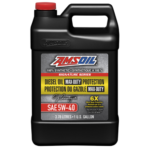How to do a compression test on an internal combustion engine.
A compression test is a real quick, easy way to look at the mechanical integrity or the health of your engine. Here’s how it’s done. A compression test requires that we crank the vehicle, but we don’t want it to start. So the first thing you’ll do is remove the fuel pump relay, if you can find it.
Another thing that will also work is to disable the coil, and that’s to take the primary power or the smaller wires away from the coil. Then it won’t spark. In this case, we’ve done both. The car has no fuel and it has no sparks. So we won’t flood the engine, and it won’t start. We get good results on a compression test. So we will start with your number one cylinder. You want to remove the cap. Use a little bit of air to ensure that there’s no dust or dirt down there. You want to use a long extension in this particular engine because the spark plug’s located down in the cylinder. Remove the spark plug. And now is a good time for a spark plug inspection. You want to examine the electrodes, both the side electrodes and the center electrodes. You want to be sure that the edges are square and that the plug looks to be in good condition.
Now’s a good time to change them if you decide that’s necessary. This compression tester has an extension tool, which is really nice. You screw that into the cylinder since the spark plug is located a little bit deeper in the motor. Then we’ll connect the compression gauge. And then we’re going to crank the vehicle, and we’re going to watch the needle on the compression gauge.
We will crank until the needle plateaus, meaning the needle stops climbing. We’ll continue cranking until the needle stops climbing. Once the needle stops climbing, you’re going to look at your reading. You’re going to want to note what that reading was, and then you’re going to repeat the process for the remaining cylinders on the engine always noting what your compression is. At the end of the test, you’ll compare your highest reading with your lowest reading, and the lowest reading should be within 10 percent of the highest reading. That’s a good rule of thumb to ensure that your engine is healthy and that all cylinders are contributing to making power and moving your vehicle down the road. So, if you look at all the results placed side by side for the different cylinders, you can see that this would be considered a healthy engine since all of the readings are very close together. If we were to see one of those results low, let’s say one cylinder was 20 or 30 psi lower than the others, that would indicate a problem; and we would need to dig into that engine deeper to try and diagnose exactly what’s wrong.
The compression test is a real good initial check on engine health.
If you have a new gasoline car or truck use AMSOIL motor oil to ensure that you will protect your investment with the best motor oils.
For diesel applications either personal cars or trucks or fleet applications learn the proper lubrication options for diesel engines here
Use the AMSOIL look up guide to determine what AMSOI engine oil is recommended for your car, truck, small engine, or powersports equipment.


